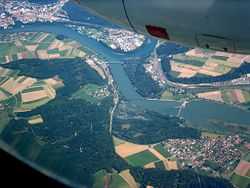Aar
| Aar | |
|---|---|
 The Aar at Bern | |
 Drainage basin of the Aar | |
| Origin | Canton of Bern, Switzerland |
| Mouth | Rhine |
| Basin countries | Switzerland, France |
| Length | 295 kilometres (183 mi) |
| Basin area | 17,779 km2 (6,865 sq mi) |
The Aar, or Aare (German Aare), a tributary of the High Rhine, is the longest river that both rises and ends entirely within Switzerland.[2]
Its total length from its source to its junction with the Rhine comprises about 295[3] km (183 miles),[2] during which distance it descends 1,565 m (5,135 ft), draining an area of 17,779 km2 (6,865 sq mi), almost entirely within Switzerland, and accounting for close to half the area of the country, including all of Central Switzerland..[3] There are more than 40 hydroelectric plants along the course of the Aare River.[4]
The river's name dates to at least the La Tène period, and it is attested as Nantaror "Aar valley" in the Berne zinc tablet which dates back to Roman Gaul. The name was latinized as Arula/Arola/Araris[5][nb 1]
Course


The Aar rises in the great Aar Glaciers of the Bernese Alps, in the canton of Bern and west of the Grimsel Pass.[2] The Unteraar Glacier is the main source for the start, along with the Finsteraar Glacier and Lauteraar Glacier.[4] It runs east to the Grimsel Hospice, below the Finsteraarhorn, and then northwest through the Haslital, forming on the way the magnificent Handegg Waterfall, 46 m (151 ft), past Guttannen. Between Innertkirchen and Meiringen, the river carves through a limestone ridge in the Aar Gorge or Aareschlucht.[2]
A little past Meiringen, near Brienz, the river expands into Lake Brienz. Near the west end of the lake it receives its first important tributary, the Lütschine. It then runs across the swampy plain of the Bödeli between Interlaken and Unterseen before flowing into Lake Thun.[2]
Near the west end of Lake Thun, the river receives the waters of the Kander, which has just been joined by the Simme. Lake Thun marks the head of navigation.[4] On flowing out of the lake it passes through Thun, and then flows through the city of Bern, passing beneath eighteen bridges and around the steeply-flanked peninsula on which the Old City is located. The river soon changes its northwesterly flow for a due westerly direction, but after receiving the Saane or Sarine it turns north until it nears Aarberg. There, in one of the major Swiss engineering feats of the 19th century, the Jura water correction, the river, which had previously rendered the countryside north of Bern a swampland through frequent flooding, was diverted by the Hagneck Canal into the Lake of Bienne. From the upper end of the lake the river issues through the Nidau-Büren channel and then runs east to Büren. The lake absorbs huge amounts of eroded gravel and snowmelt that the river brings from the Alps, and the former swamps have become fruitful plains: they are known as the "vegetable garden of Switzerland".
From here the Aar flows northeast for a long distance, past the ambassador town Solothurn[2] (below which the Grosse Emme flows in on the right), Aarburg (where it is joined by the Wigger), Olten, Aarau,[2] near which is the junction with the Suhre, and Wildegg, where the Hallwiler Aa falls in on the right. A short distance further, below Brugg it receives first the Reuss, and shortly afterwards the Limmat. It now turns due north, and soon becomes itself a tributary of the Rhine, which it surpasses in volume when the two rivers unite at Koblenz (Switzerland), opposite Waldshut, Germany. The Rhine, in turn, empties into the North Sea after crossing into the Netherlands.
Tributaries
_IMG_6765.jpg)

- Limmat
- Sihl
- Linth (main tributary of Lake Zürich)
- Reuss (see also: Reuss (river)#Tributaries)
- Kleine Emme
- Sarner Aa
- Engelberger Aa
- Schächen
- Furkareuss
- Suhre
- Bünz
- Wigger
- Murg (Murgenthal)
- Rot (Roggwil)
- Langete (Langenthal)
- Ursenbach (Kleindietwil)
- Rotbach (Huttwil)
- Emme
- Zihlkanal
- Saane (Sarine)
- Kander
- Lütschine (Lake Brienz)
Reservoirs
- Lake Wohlen, 481 m
- Niederriedsee, 461 m
- Klingnauer Stausee, 318 m
- Lake Brienz
- Lake Thun
- Lake Biel
Notes
Footnotes
References
- Bridgwater, W.; Aldrich, Beatrice, eds. (1968). "Aare". The Columbia-Viking Desk Encyclopedia (3rd ed.). New York, NY: Columbia University Press. p. 11. ISBN 978-0670230709.
- Cohen, Saul B., ed. (1998). "Aare". The Columbia Gazetteer of the World. New York, NY: Columbia University Press. p. 1. ISBN 0-231-11040-5.
- Forbiger, Albert (1848). Handbuch Der Alten Geographie 3. Leipzig, Germany: Veriag von Gustav Mayer.
- Hoiberg, Dale H., ed. (2010). "Aare River". Encyclopædia Britannica (15th ed.). Chicago, IL: Encyclopædia Britannica, Inc. p. 4. ISBN 0-85229-961-3.
- Kristol, Andres; Cattin, Florence; Meroni, Barbara et al., eds. (2005). "Aarau AG (Aarau)" [Encyclopedia of the Swiss municipality of LSG: Dictionnaire de toponymique scommunes Suisses DTS / Dizionario dei comuni toponomastico svizzeri DTS]. Lexikon der schweizerischen Gemeindenamen LSG: Dictionnaire toponymique de scommunes suisses DTS /Dizionario toponomastico dei comuni svizzeri DTS (in German) (1st ed.). Stuttgart, Germany: Huber Frauenfeld. ISBN 3-7193-1308-5.
External links
| Wikimedia Commons has media related to Aar. |
- The Aar Gorge (Aareschlucht)
 Texts on Wikisource:
Texts on Wikisource:
- "Aar". The Nuttall Encyclopædia. 1907.
- Chisholm, Hugh, ed. (1911). "Aar". Encyclopædia Britannica (11th ed.). Cambridge University Press
- "Aar". Collier's New Encyclopedia. 1921.
Coordinates: 47°36′N 8°13′E / 47.600°N 8.217°E

